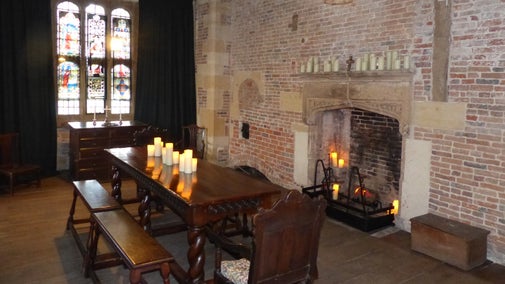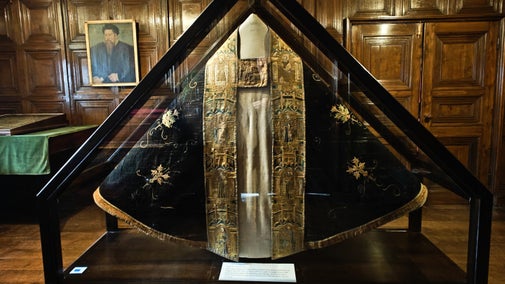
Discover more at Coughton Court
Find out when Coughton Court is open, how to get here, things to see and do and more.

There are two churches of differing denominations to visit at Coughton Court; St Peter’s Church and St Peter, St Paul and St Elizabeth’s Church. See the tomb that laid unoccupied for over 350 years, a font which could date back to Saxon times, and stained glass by John Hardman.
Found next to the house this church was built in the late 15th century by Sir Robert Throckmorton. It began life as a Catholic Church but, following Henry VIII's Reformation, is now Church of England.

Inside the church look out for the original tomb intended as the resting place of Sir Robert but left empty for over 350 years after he died on pilgrimage in the holy land.
In 1791 his descendant, another Sir Robert Throckmorton, 4th Baronet, was laid to rest in the tomb instead.
Also inside the church is the tomb of Sir George Throckmorton, son of the original Sir Robert, and his wife Katherine Vaux. Images of their 19 children can be seen on the cover of the tomb.
One of these children, another Sir Robert Throckmorton, is interred close to his parents. Portraits of both this Sir Robert and his mother, Katherine Vaux, can be seen in the house along with information about their importance in Throckmorton family history.
Other items of note in and around the church are the font and sundial, which some suggest could be of Saxon origin.
The late 17th-century clock chimes the hour on one of the three bells cast by Bagleys of Chacombe in 1686.

Close by St Peter’s Church is the Catholic Church of St Peter, St Paul and St Elizabeth. It was commissioned by Sir Robert Throckmorton, 8th Baronet, soon after the emancipation acts were passed which permitted the building of non-Anglican places of worship.
Designed by the Catholic Architect Charles Hansom (brother of J A Hansom, inventor of the Hansom Cab) it was erected in 1857 but reflects the church building style of the 14th century.
Some of the stained glass is by John Hardman, an artist who worked closely with Pugin and was a pioneer of the stained-glass revival in the 19th century.

Find out when Coughton Court is open, how to get here, things to see and do and more.

Twenty-one generations of the Throckmorton family have lived at Coughton since 1409. Over six centuries there are many stories to tell, including that of the gunpowder plot.

Explore the house and collections at Coughton Court, which has been home to the Throckmorton family for over six centuries and continues to be their home today.

Coughton Court is home to a number of historic items. Take a closer look at two of the most important items in the collection – the Throckmorton coat and the Tabula Eliensis.

Visit Coughton Court for family-friendly events and activities in the house and garden, including woodland walks and wildlife spotting.